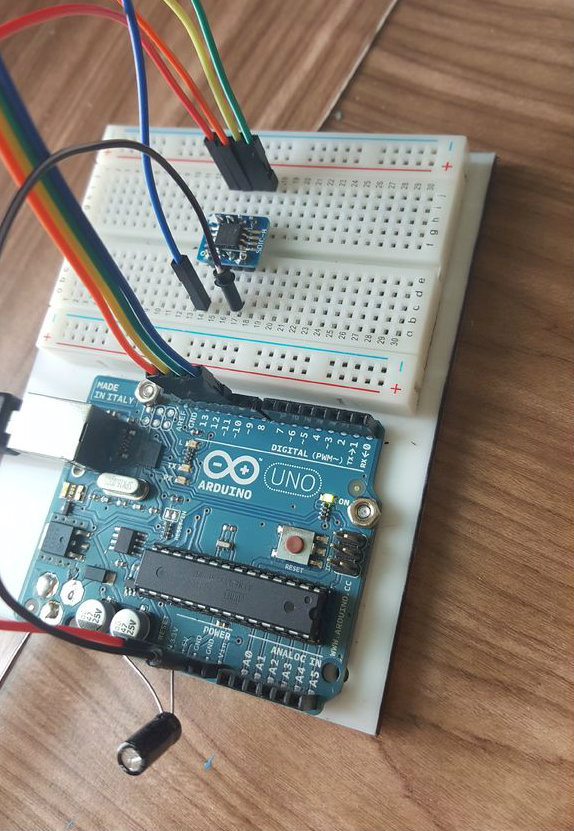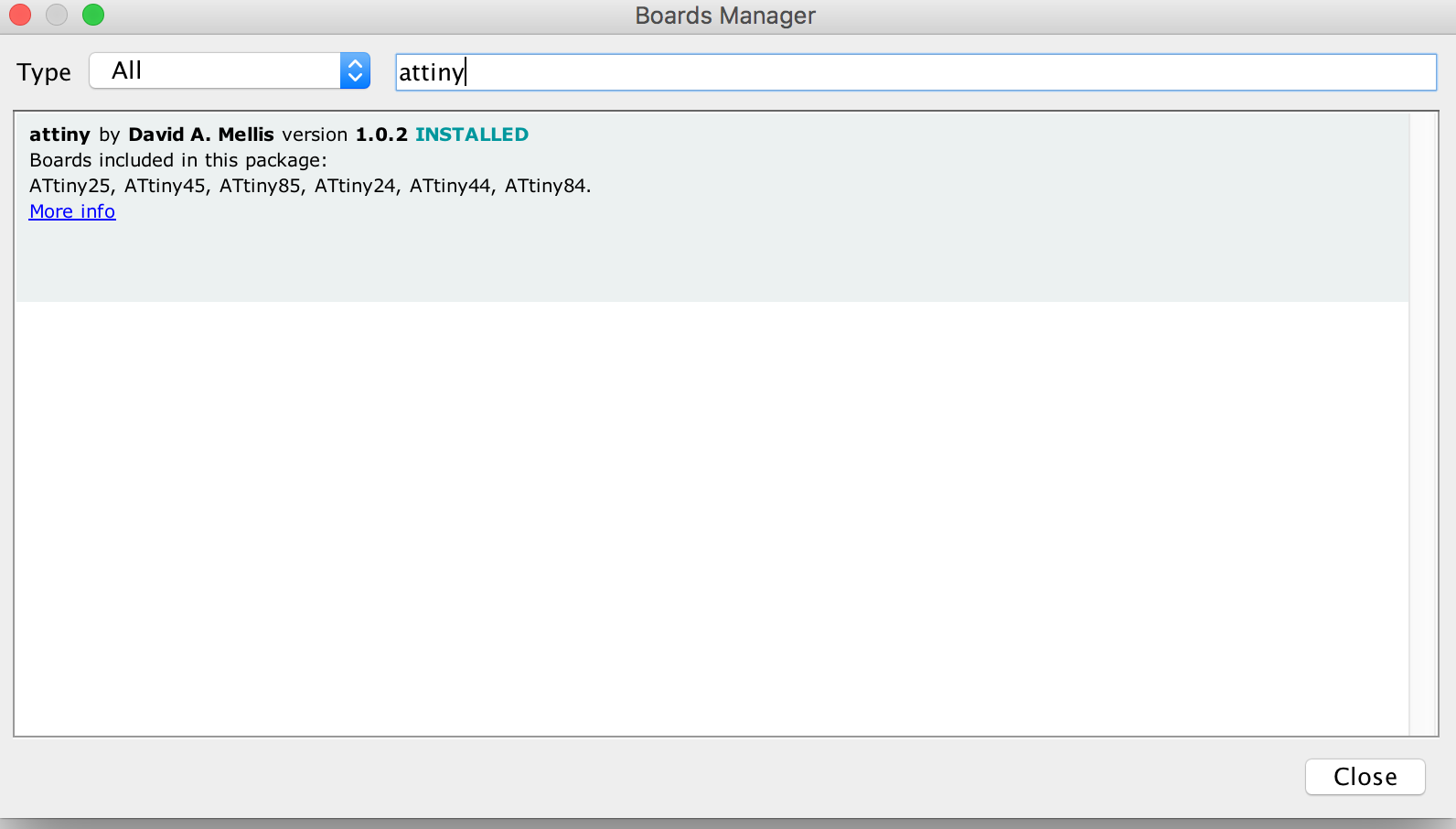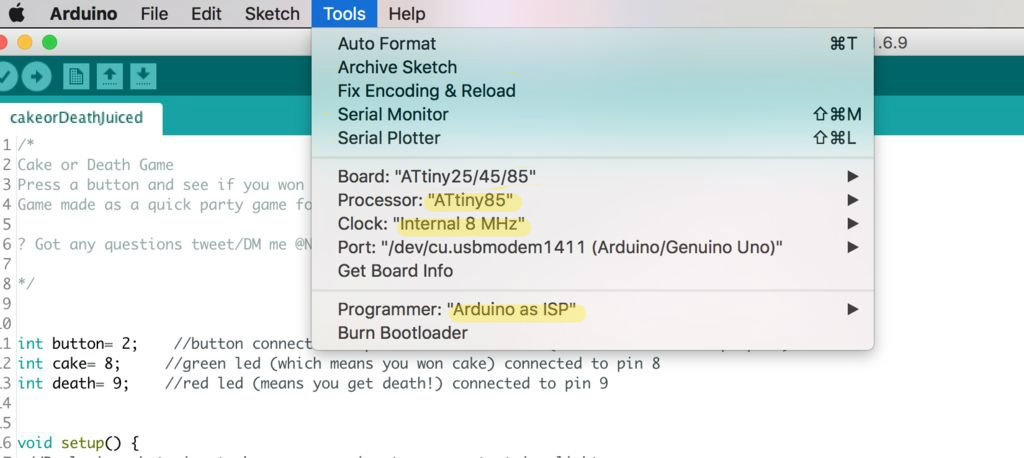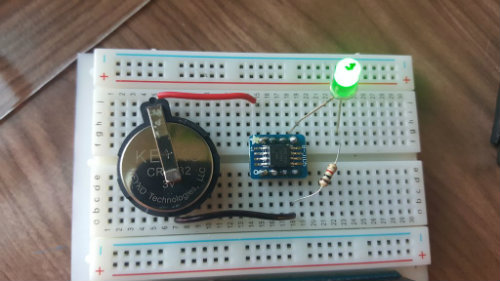How to Program an Attiny85 Using a Arduino Uno
by NemesisC in Circuits > Arduino
201638 Views, 96 Favorites, 0 Comments
How to Program an Attiny85 Using a Arduino Uno

Quick tutorial showing how to program the ATtiny85 from the Arduino IDE with the help of the Arduino Uno!
This tutorial was requested by my friend Orlando so hope it helps !
Comments,Concerns,Feedback,Requests welcomed:
@NemesisContrer8
Add Support for the ATtiny85 to the Arduino URL Board Manager

By default the Arduino IDE does not support the ATtiny85 it's required to add support for the Attiny85 to the Arduino Board Manager:
- From the Arduino IDE Go to Arduino->Preferences then scroll down to Additional Board Managers URLs
- Copy & paste the following (if you already have a board manager URL just add a comma before pasting)
Thanks David-one of the Arduino founders for writing the code!
<p>https://raw.githubusercontent.com/damellis/attiny/ide-1.6.x-boards-manager/package_damellis_attiny_index.json</p>
- Press "OK" at the bottom then restart the Arduino IDE
Install the ATtiny Board Package



- From the Arduino IDE go to Tools--> Board-->Boards Manager
- A new tab will open and at the top of the tab type: attiny
- Select Install on the Attiny by David. A Mellis
- Restart the Arduino IDE
- The ATtiny85 board should now be added ! Go to Tools--> Board-->Attiny85
Set the Arduino Uno Into ISP Mode

Since what we want is to be able to program the ATtiny85 from the Arduino IDE which requires to burn the bootloader to the ATtiny85 we will need to "prep" the Arduino fist by uploading the ISP sketch to it.
In the Arduino IDE select File-->Examples--> 11. Arduino ISP-->ArduinoISP
the ISP sketch should open and upload it to your Arduino Uno
How a Microcontrollers Pins Are Labeled

Before the connections are made there is a very important fact to know how pins on microcrontrollers/ICs are labeled.
Pin numbers used to program a chip on the Arduino IDE are based on how the chip manufacturer has internally named/aranged the pins . The manufacturer of the ATtiny85 is ATMEL (the AT in ATtiny85-actually stands for ATMEL);It's common for chips to have the first two initials of the company who makes them.
Pins are gathered into groups called "ports" these ports are labeled A,B,C etc. Each port has a number of pins which are labeled 0,1,2,3 etc and stick out on different parts of the chip which is why a microcontroller's physical pin often time will be different than the pin number used when programming the chip.
An example:
PB0 (in the above datasheet) just means pin 0 is located on Port B of the Chip.
If pin 0 was located on Port A the name would look something like PA0 (Port A pin 0)
To add to the complexity pins can have more than one fuction and be labeled multiple names.
Wrapping it all together! :
Writing a program to light an LED on pin 0 on the ATtiny85 might be confusing at first because just by looking at the chip , there is no pin 0! However, by checking the datasheet of the ATtiny85 from ATMEL-snippet shown above-pin 0 is internally located on the chip's port B (and is actually the chip's physical pin 5 )!
Connecting the Arduino to the ATtiny Pins


Have an electrolytic capacitor-10uF is recommend but I used a 22uF and it worked fine- to prevent the Arduino from restarting it's self connected to GND & RESET on the Arduino
Use a breadboard and jumper wires to make the connections bellow from the Arduino Uno to the ATtiny85:
Arduino--> ATtiny85
5V Vcc
GND GND
Pin 13 Pin 2
Pin 12 Pin 1
Pin 11 Pin 0
Pin 10 Reset
Making the ATtiny85 Arduino Compatible



By default any fresh microcontroller chip bought will not be able to be programmed with the Arduino IDE out of the box. This is why it's required to burn the Arduino bootloader onto the chip to make sure the chip will accept any programs uploaded via the Arduino IDE.
Quick checklist before pressing "burn bootloader"
- Go to Tools -> Board scroll to the bottom select ATtiny25/45/85
- Under Tools -> Processor--> 8 MHz (internal)
- Under Tools-->Programmer-->Arduino as ISP
- Check that all wiring, capacitor, and board selections are correct
- Finally select Burn Bootloader
- leave the wires connected they will be used in the next step
A message will appear saying "Done Burning Bootloader"
Uploading the Blink Sketch



Test that the ATtiny85 can now receive sketches from the Arduino IDE by uploading the blink example
- Go to File-->Example-->01.Basics-->blink
- Edit the sketch by replacing pin 13 with 0
- Make sure to still have the ATtiny85 board settings from the previous step selected
- Make sure all wiring is the same as the previous step
- Upload the sketch
- Wire an LED by connecting the anode to pin 0 (physical pin 5 ) and the cathode to a 1K resistor connected to ground (physical pin 4)
- While a resistor is not needed since the battery provides 3v (not enough to blow up an LED) it is recommended to lower the brightness of the LED
Any request for future tutorials all welcomed! Just leave a comment bellow